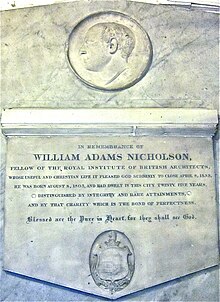William Adams Nicholson
| Nicholson, William Adams | |
|---|---|

Memorial to W. A. Nicholson in St Benedict's Church, Lincoln
|
|
| Born | 8 August 1803 Southwell, Nottinghamshire |
| Died | 1853 Boston |
| Nationality | English |
| Alma mater | Pupil of John Buonarotti Papworth, 1821-24 |
| Occupation | Architect |
| Practice | In Lincoln from 1828 |
| Buildings | Mansfield Town Hall, Bayons Manor. |
| Projects | Estate Village at Blankney, Lincolnshire |
William Adams Nicholson (1803–1853) was an English architect who worked in Lincoln and was a founding member of the Royal Institute of British Architects.
Born on 8 August 1803 at Southwell, Nottinghamshire, he was the son of James Nicholson, carpenter and joiner. James gave up his business about 1838 and became sub-agent to Sir Richard Sutton's estates in Nottinghamshire and Norfolk. William was articled about July 1821, for three years, to John Buonarotti Papworth, architect, of London. By 1824 Nicholson had returned to Southwell where he was to work with the Rev J. T.Becher on the design of the Southwell Workhouse. In 1828 he established himself at Lincoln; and there and in the neighbouring counties he built up an extensive practice. From 1839 to 1846 he was in partnership as Nicholson & Goddard, with Henry Goddard (1813–1899).Charles Baily was a pupil. Another pupil of Nicholson's was Michael Drury. His assistant John Spence Hardy and his pupil Pearson Bellamy set up the practice of Bellamy and Hardy in Lincoln after his death.
Nicholson joined the Royal Institute of British Architects as a founding fellow at its commencement. He was a member of the Lincolnshire Literary Society, and of the Lincolnshire Topographical Society. He was in attendance at Boston as a professional witness when he was suddenly taken ill, and died there on 8 April 1853. He was buried at Lincoln, in the churchyard of St. Swithin, in the parish where he had resided for many years.
In 1824 Nicholson married Leonora, the youngest daughter of William Say of Norton Street, London. His second wife, Anne Tallant, survived him.
Possibly Nicholson's most important contribution was in the design of Workhouses. His pioneering Southwell Workhouse (1824) was important forerunner of the radially planned workhouses of the New Poor Law. Nicholson was to go on to design workhouses at Glanford Brigg in 1836 and at Lincoln in 1837-8 -both of which have now been demolished.
...
Wikipedia
